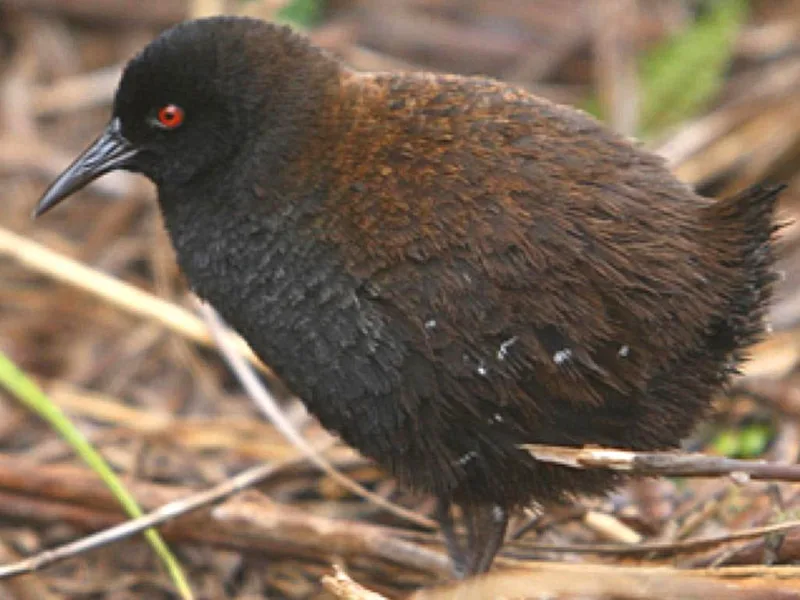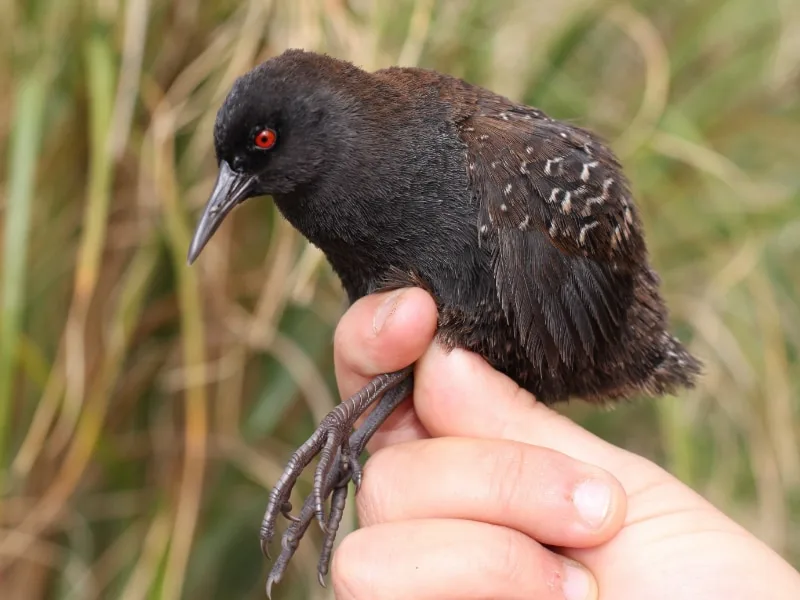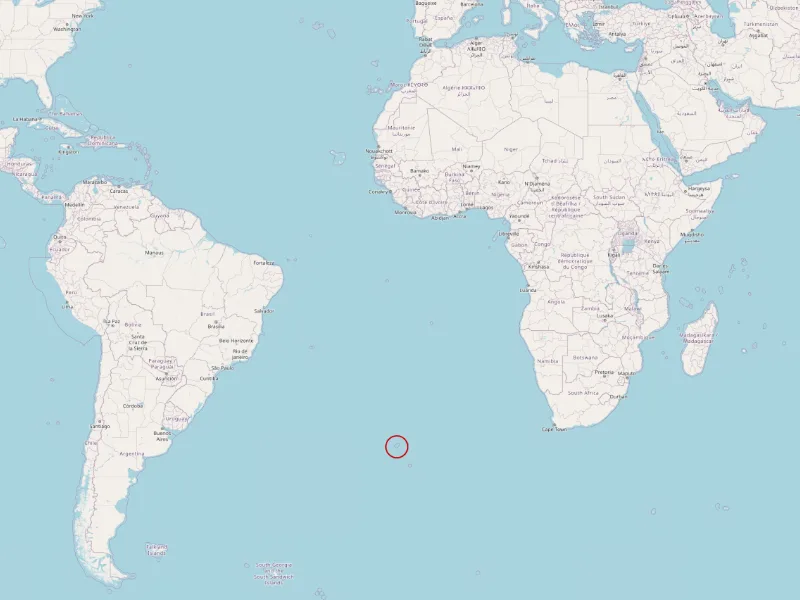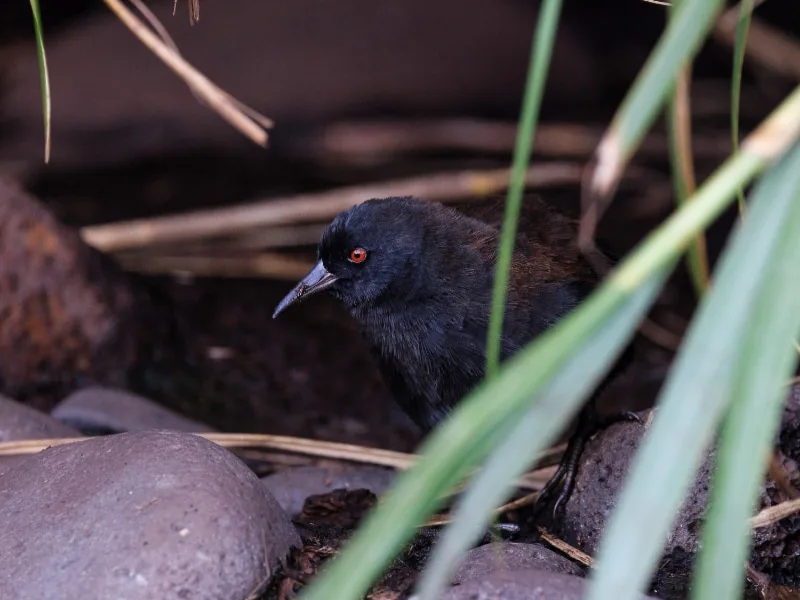The Inaccessible Island rail (Laterallus rogersi) is the world’s smallest flightless bird, measuring as little as 13 centimeters (5.1 inches) in length and weighing just 34 grams (1.2 ounces), found exclusively on Inaccessible Island in the Tristan da Cunha archipelago. Endemic to just 12.65 square kilometers (4.88 square miles) of remote volcanic terrain in the South Atlantic, this elusive rail has adapted to a predator-free environment with reduced wings, mouse-like foraging behavior, and densely vegetated habitats.
Its entire global population exists within a single location, making it both a symbol of evolutionary isolation and a species of high conservation concern. Though currently stable, its future depends on rigorous protection from invasive species and continued ecological management.

| Common name | Inaccessible Island rail |
| Scientific name | Laterallus rogersi |
| Alternative names | Inaccessible rail, Atlantisia (historic genus) |
| Order | Gruiformes |
| Family | Rallidae |
| Genus | Laterallus |
| Discovery | First recorded during the HMS Challenger expedition in 1873; formally described by P. R. Lowe in 1923 |
| Identification | Small, flightless bird with chestnut-brown upperparts and dark grey underparts; barred flanks; red eyes; reduced wings and tail; flight feathers have a soft, hair-like texture |
| Range | Endemic to Inaccessible Island, Tristan da Cunha, South Atlantic Ocean |
| Migration | Non-migratory; resident year-round across all elevations of Inaccessible Island |
| Habitat | Occupies nearly all habitat types from coastal tussock grass to upland fern-bush and forest; favors dense vegetation, sedge beds, and boulder-strewn areas with ground cover |
| Behavior | Territorial and monogamous; lives in small family groups; known for vocal interactions and ritualized displays |
| Lifespan | Presumed 5-7 years in the wild; chick mortality high, adult mortality low in absence of mammalian predators |
| Diet | Omnivorous; feeds on invertebrates (worms, centipedes, insects, larvae) and plant material (berries and seeds); forages slowly and deliberately on the ground |
| Conservation status | Vulnerable (IUCN) |
| Population | 9,100-12,200 individuals, including approximately 6,180 mature birds; stable but restricted to a single island population |
Discovery
Though likely known to Tristan da Cunha islanders who periodically visited Inaccessible Island, the Inaccessible Island rail was not scientifically documented until the late 19th century. The earliest recorded mention comes from the HMS Challenger expedition in October 1873. While the expedition did not obtain a specimen, naturalist Sir Charles Wyville Thomson noted accounts from the Stoltenhoff brothers (two German settlers who had spent two years living on the island) and included their observations in his report.
Subsequent visits in the early 20th century, including attempts by Lord Crawford in 1905 and the Shackleton-Rowett Expedition in 1922, also failed to collect specimens. However, during the latter voyage, expedition members entrusted collecting equipment to Reverend H.M.C. Rogers, then chaplain on nearby Tristan da Cunha. In 1923, Rogers successfully sent a series of study skins and preserved specimens to the Natural History Museum in London. These enabled physician and ornithologist Percy Roycroft Lowe to formally describe the species later that year at a meeting of the British Ornithologists’ Club.
Lowe assigned the bird to a new genus and species, Atlantisia rogersi. The genus name Atlantisia was inspired by the mythical sunken island of Atlantis, reflecting the species’ extreme isolation. The species epithet rogersi honored Reverend Rogers, who was instrumental in securing the type specimens.
At the time of description, Lowe believed the bird’s ancestors had colonized the island via a sunken land bridge – a hypothesis consistent with pre-plate tectonics biogeographical thinking. This view was gradually revised as geological and evolutionary understanding progressed, and by the mid-20th century, it was widely accepted that the ancestors of the Inaccessible Island rail had arrived by flight and subsequently lost the ability to fly, like many insular rail species.
The rail’s taxonomic placement has remained contentious for much of the 20th century. Lowe originally considered it distinct from known rail lineages, speculating relationships with African crakes (Crecopsis egregia) or even swamphens (Porphyrio spp.), primarily based on plumage traits.
In 1973, American paleontologist Storrs Olson proposed that Atlantisia rogersi belonged to a group of relict “pro-Rallus” rails with wide prehistoric distributions, linking it to genera such as Dryolimnas and Lewinia. Olson also controversially grouped the extinct Ascension crake (Mundia elpenor) and Saint Helena swamphen (Aphanocrex podarces) into the genus Atlantisia, but later studies rejected this classification.
Bourne and colleagues (2003) demonstrated that these similarities were the result of convergent evolution rather than shared ancestry, leading to the resurrection or establishment of separate genera (Aphanocrex and Mundia) for the extinct taxa. As a result, the Inaccessible Island rail became the sole species retained in Atlantisia.
A major taxonomic shift occurred following the molecular study by Stervander et al. (2019), which used full mitochondrial genomes and additional nuclear markers to resolve the bird’s evolutionary history. Their findings placed the species firmly within the Laterallus clade – a group of mostly South American crakes that includes the dot-winged crake (Laterallus spiloptera), the black rail (L. jamaicensis), and likely the Galapagos crake (L. spilonota). This genetic evidence supported a relatively recent colonization of Inaccessible Island from South America approximately 1.5 million years ago. The study called for a formal reassignment of the species to the genus Laterallus, under the new combination Laterallus rogersi.
This molecular reclassification underscores the challenges of rail taxonomy, which has historically been based on morphology despite widespread convergent evolution in insular environments. It also confirms that, like several other land birds of the Tristan da Cunha archipelago, the Inaccessible Island rail originated in South America rather than Africa or the Old World. With its revised phylogenetic position and biogeographic origin clarified, Laterallus rogersi now serves as a model for studying insular evolution, flight loss, and endemism among birds.
Identification
The Inaccessible Island rail is the smallest known extant flightless bird, measuring between 13 and 15.5 centimeters (5.1 to 6.1 inches) in body length and weighing between 34 and 49 grams (1.2 to 1.7 ounces). Despite its minute size, it is a robust, ground-dwelling rail with strong legs and a compact form. Sexual dimorphism is present but relatively subtle: males average 40.5 grams (1.43 ounces) in weight, while females average 37 grams (1.3 ounces). Both sexes share a similar plumage pattern, though females tend to appear slightly paler overall.

Adult plumage is characterized by dark chestnut-brown upperparts and dark grey underparts, with irregular white barring on the flanks and belly. The head is a uniform dark grey, and the eyes are a striking red in both sexes. The female’s plumage shows a faint brown wash on the underparts, and juveniles are noticeably duller and lack the barring seen in adults. The short, black bill is shorter than the length of the head and tapers gently. The tail is reduced to a length of around 3.5 cm, with coverts nearly as long as the tail feathers themselves, further minimizing tail visibility.
Flight structures are heavily reduced. The wings are significantly smaller and weaker than those of volant rails of comparable size. The flight feathers appear ragged due to the degradation of feather structure – many barbules fail to interlock properly, giving a hair-like or filamentous appearance. Although not all flight feathers are degenerate, none are functional for flight. The sternum is similarly reduced, lacking the robust keel required for the attachment of powerful flight muscles.
The Inaccessible Island rail also exhibits physiological traits often associated with insular adaptation. Studies have recorded a basal metabolic rate approximately 60-68% of the expected value for a bird of its mass. While this trait has sometimes been linked to flightlessness, comparative research indicates that low BMR in this species more likely reflects ecological pressures of island living, specifically, a predator-free, saturated environment that favors energy conservation over high mobility.
Vocalization
The Inaccessible Island rail is a highly vocal species, a trait likely shaped by its dense, low-visibility habitat of thick vegetation. Acoustic signals are essential for territory defense, pair bonding, and coordination among family members. A long, strident trill is used in territorial displays and during interactions between pair members. Confrontations between rivals involve complex vocalizations, including a repeated “keekeekeekeekee,” sometimes extended into “keekeechitrrrr.”
Victorious individuals may emit a rapid “weechup weechup” series following aggressive encounters, and foraging birds often produce a patterned call resembling “tchik tchik tchok tchik.” Alarm calls, typically triggered by predators such as the Tristan thrush, are short, hard “chip” notes. During incubation, trilling vocalizations help maintain contact between partners. Prior to a nest exchange, the incubating bird may give a soft “chip chip chip,” although pairs fall silent when potential threats approach the nest.
Range
The Inaccessible Island rail is confined entirely to Inaccessible Island, a remote and uninhabited volcanic island in the Tristan da Cunha archipelago, located in the central South Atlantic Ocean. The island, which spans approximately 12.65 square kilometers (4.88 square miles), lies more than 2,000 kilometers (1,250 miles) from the nearest continental landmass and remains the sole natural habitat for the species. It is not found on neighboring islands such as Tristan da Cunha or Nightingale Island, despite their proximity.

Migration
The Inaccessible Island rail is non-migratory and entirely sedentary. There is no evidence of seasonal movement or altitudinal dispersal across the island. Individuals occupy territories throughout the year, and the species’ complete life cycle takes place within the boundaries of Inaccessible Island.
Habitat
This species is remarkably adaptable for a flightless bird and occurs in nearly all vegetation zones on Inaccessible Island, ranging from sea level to elevations of at least 449 meters (1,473 feet). It is present even on steep coastal slopes and cliff faces. The highest population densities are observed in lowland coastal areas dominated by dense tussock grass, particularly where it is intermixed with sedge beds and ferns, with up to 15 individuals per hectare recorded in these habitats.
Inland, the rail is found in upland fern-bush heath and forested zones on the island’s central plateau. These regions are dominated by wind-stunted tree-ferns and Island Cape myrtle, the latter forming a sparse canopy up to 5 meters (16.4 feet) tall in sheltered areas. In these higher-altitude habitats, population densities are considerably lower, averaging two birds per hectare.
Although it forages across a broad range of environments, including boulder beaches, wet depressions, and even short vegetation, its presence has not been confirmed in dry, open grasslands on volcanic cinder cones. However, the apparent absence from such areas may be due to limited sampling rather than true avoidance.
Across all habitats, the species exhibits a strong preference for ground-level cover. It frequently uses narrow pathways formed through repeated passage in dense vegetation and takes advantage of natural cavities among rocks and root systems for concealment, foraging, and nesting.
Behavior
The Inaccessible Island rail exhibits a sedentary and highly localized lifestyle, shaped by its insular environment and flightlessness. It is monogamous and lives in small family groups that defend compact territories, especially in high-quality habitat such as dense tussock grasslands. Territories in these areas typically range from 100 to 400 square meters (1,100-4,300 square feet), among the smallest known for any bird. These restricted ranges lead to frequent encounters between neighboring individuals, often resulting in ritualized displays or vocal confrontations.
Territorial disputes begin with loud trills or twittering vocalizations. Competing birds may approach one another with heads lowered and bills pointed toward the ground in a stylized posture. They often circle each other at close distance, maintaining visual contact until one individual withdraws or a brief physical skirmish occurs. Despite the potential for aggression, these interactions are typically resolved with minimal contact, suggesting a well-developed behavioral repertoire for mitigating conflict in densely populated habitats.
Although the island lacks mammalian predators, predation pressure still exists. The brown skua (Stercorarius antarcticus) is the only known avian predator of adult rails, although it consumes them infrequently. In contrast, the Tristan thrush (Turdus eremita) poses a significant threat to chicks, and is believed to be a major source of juvenile mortality. Adult rails respond to the presence of predators with short, sharp alarm calls. These warnings provoke heightened vigilance in nearby adults, while chicks respond by falling silent and seeking cover.

The species is well adapted to its ground-dwelling existence. It moves swiftly and silently through dense vegetation using narrow tunnels it helps maintain with repeated passage. Its body morphology (short tail, reduced wings, and compact build) favors agility in confined spaces over open movement. Vocal communication plays a prominent role in social cohesion, territorial maintenance, and predator avoidance, compensating for the limited visibility in the island’s dense undergrowth.
Parasitism is minimal but documented. Two species of chewing lice have been recorded from the Inaccessible Island rail: Pseudomenopon scopulacorne and Rallicola (Parricola) zumpti. The latter has not been found on any other bird species from Inaccessible Island. A third, initially described as a new species (Pseudomenopon rowani), was later synonymized with P. scopulacorne, a species with a broad host range.
Breeding
The Inaccessible Island rail is a seasonal breeder with a defined reproductive period extending from October to January. It is monogamous, forming long-term pair bonds, and breeding pairs are territorial throughout the nesting season. Pairs cooperate closely in all aspects of reproduction, from nest construction to chick rearing. Although direct observations of courtship are scarce, vocal exchanges, particularly soft “chip chip chip” calls, precede incubation shift changes and likely play a role in pair coordination and bonding.
Nesting occurs at ground level in dense vegetation, particularly among clumps of tussock grass, sedges, or beneath ferns. Nests are typically situated at the base of a plant or embedded within a thick tuft, providing both structural support and concealment. The nest itself is domed, with an oval or pear-shaped structure, and constructed almost entirely from surrounding plant material. Where tussock grass is used, coarse outer layers are reinforced with finer interior linings. Some nests also incorporate leaves from introduced plants such as apple or willow when available. Each nest features a single entrance, often connected to the surrounding habitat by a narrow tunnel or track up to 50 centimeters (20 inches) long.
The species has an unusually small clutch size for a rail, laying only two eggs per breeding attempt. Eggs are relatively large in proportion to the female’s body size and resemble those of the corn crake (Crex crex), with a base color of greyish milk-white and blotches of brown-rufous and lavender-mauve concentrated near the apex. The precise incubation period remains undocumented, but observations suggest that both sexes participate actively, with males tending to spend more time on the nest. Incubating birds are provisioned by their partners, who deliver food to the nest or its immediate vicinity. The vocalizations exchanged during incubation duty changes increase in frequency and intensity if the partner delays response.
Hatching is asynchronous, with chicks emerging up to 32 hours apart. The initial pipping phase may begin as much as 45 hours before hatching, and the process of emerging from the egg can take more than 15 hours. Newly hatched chicks are precocial and covered in fine black down. The bill, legs, and feet are black, while the interior of the mouth is a distinctive silvery color. Both parents participate in brooding and feeding the chicks, although chick survival is heavily influenced by predation pressure, particularly from the Tristan thrush.
Lifespan
The lifespan of the Inaccessible Island rail has not been formally documented, and no verified records exist of either average or maximum longevity. As the species has never been kept in captivity, all available information is derived from field observations. However, based on its life-history traits, such as low reproductive output, stable territories, and a lack of mammalian predators, adult individuals are presumed to live for multiple years in the wild, possibly ranging between 5 and 7 years.
Chick mortality is high, primarily due to predation by the Tristan thrush, which represents the leading threat to juvenile survival. In contrast, adult mortality appears to be low. The island remains free of introduced predators, and adult rails are only occasionally preyed upon by brown skuas, which do not target them frequently.
Diet
The Inaccessible Island rail is an opportunistic omnivore with a diet that includes a wide variety of small invertebrates as well as some plant material. Its foraging behavior is slow, methodical, and highly deliberate, often likened to that of a mouse in both motion and ecological function. This species fills a unique ground-foraging niche within Inaccessible Island’s predator-free environment, where it is among the dominant terrestrial insectivores.
Animal prey forms the core of the diet. The species feeds on earthworms, amphipods, isopods, mites, and a broad range of insects and their larvae, including beetles, flies, moths, and caterpillars. Centipedes are also consumed, with one introduced species of centipede reportedly representing a significant food source. The rail actively searches for prey by moving slowly through dense vegetation and among boulders, using its bill to probe leaf litter and soil.
In addition to invertebrates, the rail supplements its diet with plant matter. Documented food items include berries from Empetrum and Nertera species, as well as seeds from dock plants (Rumex spp.). Unlike the Tristan thrush, which also inhabits the island, the Inaccessible Island rail does not scavenge carrion or feed on dead fish, indicating a primarily active foraging strategy focused on live prey and fresh plant materials.
Threats and conservation
The Inaccessible Island rail has an extremely limited global range, confined to a single island of just 12.65 square kilometers (4.88 square miles). Despite this, the species remains locally abundant and is currently considered stable. The most recent population estimate places the total number of individuals between 9,100 and 12,200, with a best estimate of approximately 6,180 mature individuals. Previous estimates from the early 1990s suggested a smaller population of around 8,400 birds. However, due to inconsistencies in historical data and differing methodologies, these numbers are not directly comparable and cannot reliably be used to infer long-term trends.
Although the population appears stable, the species is listed as Vulnerable on the IUCN Red List. This classification reflects its restricted range and the potential for rapid population collapse should a major threat, particularly the introduction of invasive species, reach the island. As the world’s smallest flightless bird, the Inaccessible Island rail is highly vulnerable to stochastic events, especially those involving predators to which it has no natural defense.
Threats
The most pressing threat to the Inaccessible Island rail is the accidental introduction of invasive mammalian predators, such as house mice, brown rats, or black rats. These species are not currently present on Inaccessible Island but are found on nearby Tristan da Cunha and Nightingale Island. Given the relative ease of modern boat access to Inaccessible Island, particularly by small vessels from Tristan, the risk of unintentional species transfer remains constant. Rodents pose a grave risk to ground-nesting birds, especially flightless island species, and could lead to rapid population decline or extinction.
Additional concerns include the introduction of non-native invertebrates, which could disrupt the island’s invertebrate community and reduce the rail’s food supply. The colonization of potential avian competitors might also introduce new ecological pressures. Historical fires, recorded in 1872 and 1909, are assumed to have caused significant rail mortality, although no fires have occurred since. Chick mortality remains high, driven primarily by predation from the Tristan thrush and exposure to wet weather. However, these pressures are not considered population-level threats under current conditions.
Conservation efforts
A number of effective conservation measures are already in place. In 1994, Inaccessible Island was designated a nature reserve by the Tristan da Cunha Island Council, providing a formal framework for habitat protection. Access to the island is now tightly restricted, with only Tristan islanders permitted to land for traditional activities such as collecting driftwood and guano. Scientific access is controlled through a permitting process. The island was incorporated into the Gough and Inaccessible Islands World Heritage Site in 2004, enhancing international recognition and protection.
Invasive plant species such as New Zealand flax have been actively removed from both coastal and upland habitats, and are now largely confined to a small area of cliffside terrain near the Waterfall. A formal management plan was first issued in 2001 and updated in 2010, with subsequent revisions underway as of 2016. Ongoing priorities include monitoring rail populations, managing access, and ensuring compliance with strict biosecurity protocols to prevent the introduction of alien species.
Proposed additional measures include improving education among the local community regarding the dangers of biological invasions, removing rodent populations from Tristan da Cunha to reduce the risk of inter-island transfer, and exploring the feasibility of establishing captive or backup populations on other predator-free islands. However, translocation efforts would need to be weighed carefully against the risk of disrupting endemic invertebrate faunas on those islands.
Future outlook
The long-term survival of the Inaccessible Island rail remains closely tied to the continued ecological integrity and isolation of its native habitat. While current population estimates suggest a stable and abundant species within its tiny range, its fate is precariously balanced on the island’s ongoing protection from invasive species.
The absence of introduced predators, competitors, and pathogens has so far preserved the conditions under which this flightless rail has flourished, but even a single accidental introduction, particularly of rats or mice, could lead to irreversible declines.
Active conservation measures, such as biosecurity enforcement, habitat management, and limited access policies, have proven effective to date. However, the increasing connectivity of remote islands, changes in climate, and inter-island movement of people and materials all represent persistent risks.
Continued vigilance, regular population monitoring, and community-based awareness programs will be essential to maintaining the species’ current status. While backup measures such as captive breeding or translocation have been proposed, these should be approached with caution given the potential impacts on other island ecosystems.
Further reading
